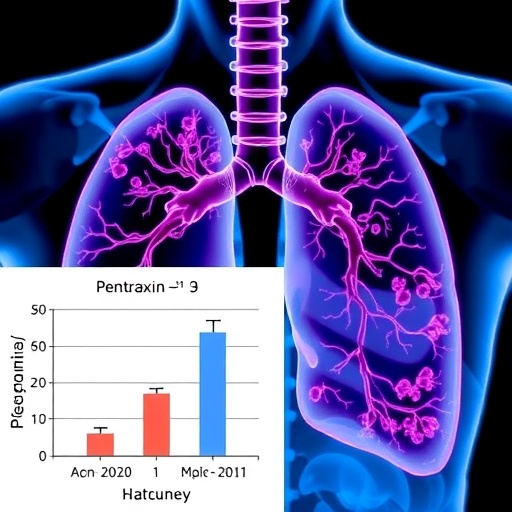In an era where machine learning is revolutionizing healthcare, a recent study has illuminated the potential of artificial intelligence in predicting outcomes for patients suffering from community-acquired pneumonia (CAP). The researchers, led by Voza et al., have specifically focused on integrating pentraxin-3, a protein associated with inflammation and response to infection, into a sophisticated machine learning model aimed at enhancing clinical decision-making. Their work, published in the Journal of Translational Medicine, provides insights that could be transformative not only for clinicians but also for patients who grapple with this common yet potentially severe respiratory condition.
Community-acquired pneumonia remains a leading cause of morbidity and mortality worldwide, particularly among vulnerable populations such as the elderly and those with compromised immune systems. The disease often requires extensive medical intervention, from hospitalization to follow-up care, to ensure favorable outcomes. Traditional prognostic models have utilized various clinical parameters and laboratory findings, yet these approaches sometimes lack the precision needed in predicting individual patient outcomes. This gap underscores the urgent need for more reliable predictive tools that can assist healthcare providers in evaluating patient risks effectively.
In this pioneering study, the researchers set out to construct a machine learning model that integrates clinical data, laboratory results, and importantly, the levels of pentraxin-3. The protein pentraxin-3 is known to play a crucial role in the body’s immune response, particularly during infections. Elevated levels of this acute-phase protein have been correlated with worse outcomes in patients with CAP, making it a valuable biomarker worth studying further. By harnessing the power of machine learning, the team aimed to explore the predictive capabilities of pentraxin-3 alongside other clinical variables.
The machine learning model was developed using a dataset derived from a cohort of patients diagnosed with CAP. Researchers meticulously collected data that encompassed various demographic information, clinical assessments, laboratory test results, and importantly, pentraxin-3 levels. This comprehensive approach allowed the team to train the machine learning algorithms effectively, turning the substantial volume of patient data into insights that could drive clinical application.
One of the key features of the model was its ability to process complex datasets and identify non-linear relationships between variables that traditional statistical models might overlook. Unlike conventional prognostic tools that often rely heavily on linear assumptions, machine learning models can capture intricate patterns in the data that reflect the biological complexity of pneumonia. This capability becomes especially advantageous when predicting outcomes in a multifaceted condition like CAP, where the interplay between various clinical features can significantly influence patient trajectories.
For the validation of their model, the researchers split their dataset into training and testing subsets. This method allowed them to evaluate how well the machine learning model could predict clinical outcomes, such as the need for hospitalization, intensive care unit admission, or mortality within a defined time frame. By using rigorous evaluation metrics, the study provided robust evidence of the model’s effectiveness, enhancing its credibility as a potential tool for clinical practice.
The results were promising, demonstrating that the inclusion of pentraxin-3 measured alongside traditional clinical variables markedly improved the model’s predictive accuracy. The enhanced prediction capability signifies a potential shift in how clinicians may evaluate and manage patients with community-acquired pneumonia in the future. It opens the door for more personalized medicine approaches, where treatment and intervention strategies can be tailored based on more precise predictions of patient outcomes.
Moreover, the researchers highlighted the importance of integrating artificial intelligence in routine clinical care. As healthcare continues to evolve, the demand for tools that can aid in decision-making and risk assessment becomes increasingly critical. Utilizing machine learning models may not only streamline the congestion in emergency services but also reduce unnecessary antibiotic prescriptions, thereby addressing issues related to antimicrobial resistance—a pressing global health challenge.
In contemplating the broader implications of their findings, Voza and colleagues emphasize the ethical considerations tied to the use of machine learning in clinical settings. Transparency in how predictive models are built and applied is crucial, ensuring that healthcare providers understand the underlying algorithms. Additionally, ongoing education and training will be necessary for clinicians to interpret the model outputs effectively and integrate them into their workflow confidently.
The study also sparks discussions on future research directions. While the results are significant, further clinical trials are necessary to test the model’s applicability across diverse populations and settings. Researchers anticipate a collaborative approach involving multi-center studies that encompass varied demographic backgrounds, which could further validate and bolster the reliability of their findings.
Furthermore, as the field of machine learning in healthcare advances, researchers may explore the integration of additional biomarkers and clinical elements into models. Leveraging a wide array of data, including genomic and proteomic information, could create more windows of opportunity for predicting patient outcomes and enhancing therapeutic strategies. In time, this could usher in a new era of precision medicine where treatment plans are meticulously tailored based on a comprehensive understanding of individual patient profiles.
In conclusion, the groundbreaking work by Voza et al. illustrates the promising intersection of machine learning and clinical medicine. Their innovative approach to predicting outcomes in community-acquired pneumonia through the lens of pentraxin-3 serves as a significant leap forward in enhancing patient care and management. As healthcare providers increasingly embrace technology-driven solutions, studies like these reaffirm the potential of machine learning to transform medical practice, ultimately leading to improved patient health outcomes and a deeper understanding of diseases that affect millions globally.
The ongoing dialogue around artificial intelligence in healthcare is one that emphasizes the balance between innovation and ethical responsibility. The positive implications of such research provide both a beacon of hope for more effective treatment strategies and an inspiration for the continued advancement of healthcare technologies.
Moving forward, the lessons drawn from this study can inspire further exploration into the innate complexities of illnesses and the optimization of predictive methods. As researchers lay down the foundations of machine learning in medicine, the promise of a future where accurate, data-driven decisions enhance clinical practices stands at the forefront of modern healthcare evolution.
Subject of Research: Machine learning model including pentraxin-3 in predicting outcomes in community-acquired pneumonia.
Article Title: A machine learning model including pentraxin-3 as predictor of outcomes in community-acquired pneumonia.
Article References:
Voza, A., Aliberti, S., Bonelli, F. et al. A machine learning model including pentraxin-3 as predictor of outcomes in community-acquired pneumonia.
J Transl Med 23, 1205 (2025). https://doi.org/10.1186/s12967-025-07142-6
Image Credits: AI Generated
DOI: 10.1186/s12967-025-07142-6
Keywords: Machine learning, pentraxin-3, community-acquired pneumonia, predictive model, healthcare technology, patient outcomes.
Tags: advanced machine learning modelsArtificial Intelligence in Medicineclinical decision-making toolscommunity-acquired pneumonia outcomeselderly pneumonia risk assessmenthealthcare data integrationimproving patient outcomes in pneumoniainflammatory biomarkers in respiratory diseasemachine learning in healthcarePentraxin-3 in pneumonia predictionpredictive analytics for CAPprognosis in pneumonia treatment





